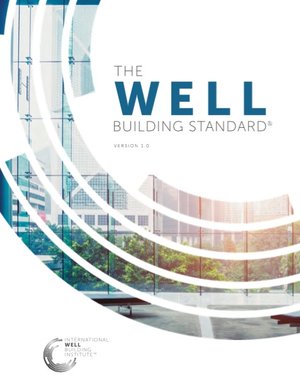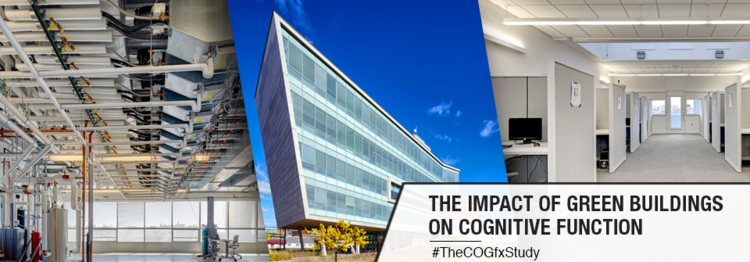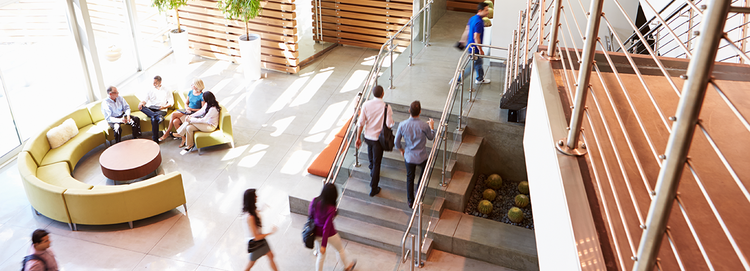In recent years, the green building industry has made significant strides in improving the way buildings are designed, built, and perform. Enhanced energy efficiency, reduced resource consumption and the use of more sustainable materials is helping to limit the adverse consequences of our built environment on our natural environment. These interdisciplinary efforts aim to preserve the environment while mitigating the ramifications of climate change.
We know these efforts are critical. But just what exactly is our “environment”?
Turns out, we spend 90% of our time indoors. Our environment is within buildings practically all day, every day. This begs the question: What work are we doing to ensure our indoor environments are optimal (or at least suitable) to support and sustain healthy, productive people?
With this in mind, the green building industry is now expanding its expertise beyond bricks and mortar to focus on how buildings can impact the health and habits of human occupants — both positively and negatively. Business stands to benefit from this expanded focus, as Gallup estimates that actively disengaged employees add up to an estimated $450 billion to $550 billion in lost revenue each year. Investing in the health, happiness and wellness of employees yields additional measurable results in the form of reduced health care costs and increased productivity and efficiency.
Well, Well, Well…
Enter the WELL Building Standard, an evidence-based system for measuring, certifying and monitoring the performance of building features that impact health and well-being. Designed to work in concert with the LEED Green Building Rating System, the Living Building Challenge, and other green building standards, WELL is third-party-certified through Green Building Certification, Inc. — the same body that certifies LEED projects. WELL is grounded in the belief that human health and wellness should be at the center of design, and advances a core set of seven criteria across the whole building:

Air: Optimize & achieve indoor air quality;
Water: Optimize water quality while promoting accessibility;
Nourishment: Encourage healthy eating habits by providing healthier food choices, behavioral cues, and knowledge about nutrient quality;
Light: Minimize disruption to the body’s circadian rhythm using window performance and design, light output and lighting controls, and task-appropriate illumination levels;
Fitness: Utilize building design technologies and knowledge-based strategies to encourage physical activity;
Comfort: Create a distraction-free, productive, and soothing indoor environment;
Mind: Promote health and wellness awareness by providing regular feedback about the environment through design elements and state-of-the-art technology.
Addressing indoor air quality (IAQ) is not new in the building industry. However, proof of its far-reaching impact within the built environment is growing. From the first onset of “sick building syndrome” reported 30 years ago, to last year’s Harvard School of Pubic Health study highlighting improved cognitive performance among employees working in green offices, there is a clear health correlation between buildings and occupants.

According to the World Green Building Council‘s own 2013 study, The Business Case of Green Building, optimizing building air quality, alone, could result in an 11% improvement to productivity. The ripple effect of indoor air quality extends to our productivity, health, and overall well-being and happiness — all factors in how we function in our professional lives. The WELL Building Standard recognizes a building’s connection to its environment, and its occupants by fostering a positive relationship between the two through design and healthy behavioral patterns.
Portals of productivity
Windows and doors have a longstanding role in connecting building occupants with natural light and ventilation, as well facilitating views to the outdoors. As fellow humans that also work inside buildings, we know that connecting people with daylight and natural beauty outside our windows is the most powerful way our company can help to improve human happiness, productivity and well-being.
As the building industry advances along its sustainability journey by looking beyond physical materials to realize the value and significance of occupant behavior and comfort, the introduction of the WELL Building Standard is perfectly timed. The seven concepts it promotes in meaningfully addressing human health – in conjunction with our core green building concepts — will result in positive outcomes for people, the planet and for business.
Andersen is encouraged to see the recent shift focused on nurturing a healthier, more engaged workforce. After all, there’s no indication we’ll be spending less time indoors anytime soon, but with certifications like WELL, we can transform the way we understand connections between human health, well-being, and productivity within — and beyond — the bricks and mortar of our built environment.
___________________________________________________________________

Based in Minneapolis, the author is Andersen’s director of sustainability and a board member at the nonprofit Environmental Initiative. She notes that Andersen was one of the first window and door manufacturers to receive SCS Indoor Advantage Gold certification, a stringent standard for low-emitting products available in California. This is Ms. Clark’s second guest contribution written exclusively for BuiltWorlds.


Discussion
Be the first to leave a comment.
You must be a member of the BuiltWorlds community to join the discussion.